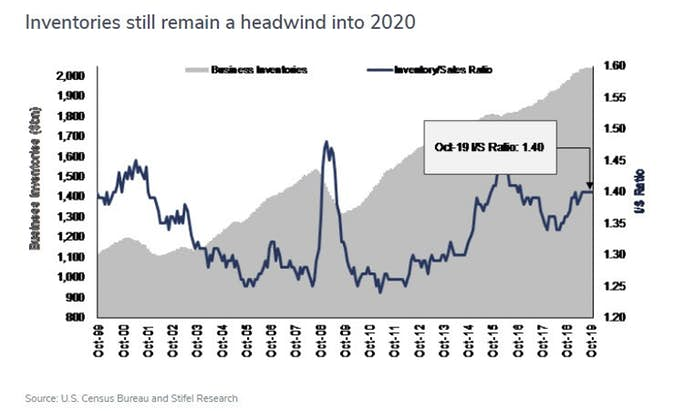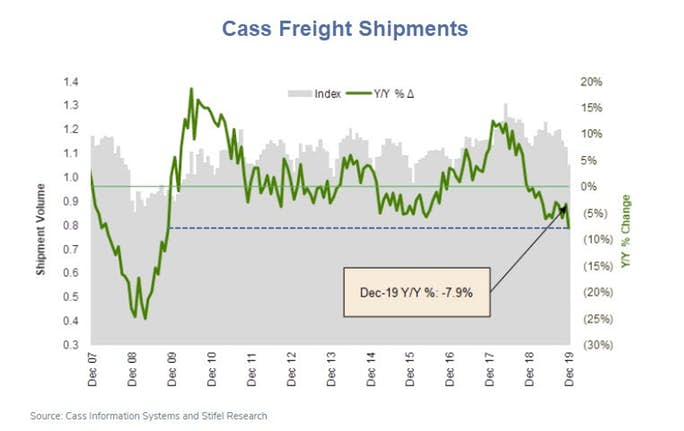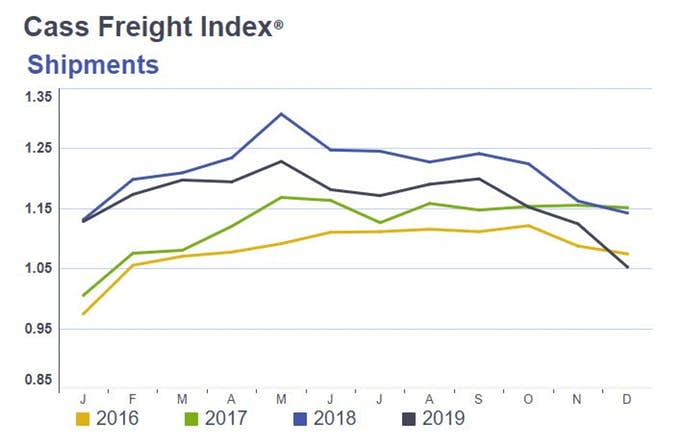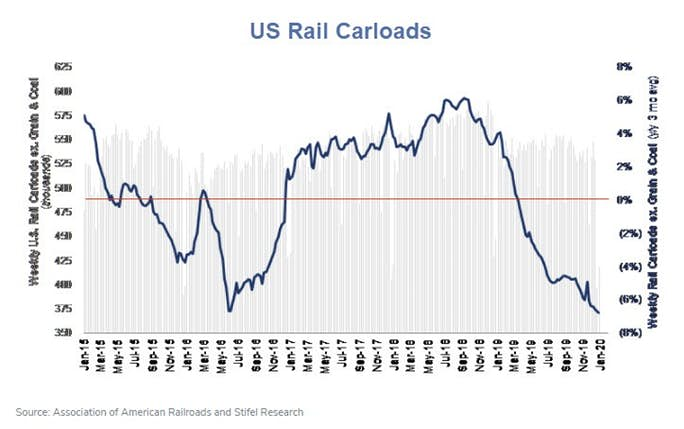Year-over-year, the Cass shipping index turned in its worst performance since the Great Recession.
The Cass Freight Shipment Index is still sounding recession alarm bells.
There is lots of hope in the stock market and the freight market for a better 2020, but the trends have yet to turn. Maybe with the January index readings? Doubtful, as the index (both shipments and expenditures) normally falls off sequentially from December to January, which would imply another negative y/y comp ahead. Our view is that the second quarter of 2020 has the best chance of seeing actual y/y growth in shipments and freight costs, if traditional seasonal freight patterns hold, as the second quarter of 2019 did not see the typical seasonal surge in activity.
Shipment volumes dropped 7.9% vs December 2018 levels, as the index posted its lowest reading since January 2018. It was also the steepest y/y decline since the Great Recession of 2008-2009. Although there were the same number of working days in December 2019 and December 2018, some industry participants we’ve spoken with about the sluggish end to the year cited Christmas and New Year’s Day both falling on a Wednesday as the reason for soft volume and low productivity the last week or so.
Shipments
Shipping volumes in december of 2019 were lower than in 2018, 2017, and 2016.
Inventories

Regardless of the holiday effect, the freight market is weak, largely due to higher inventories and contraction in the manufacturing economy, as noted by December’s 2019-low ISM reading of 47.2 (its lowest level since June 2009). And while we expect comps to ease and volumes to flatten out, we are not forecasting much growth in terms of freight volumes in 2020. The U.S. industrial economy – rebound or no rebound – will likely be the biggest swing factor. And the tariff relief from the Phase 1 deal seems to be just that – a relief for some, but not a stimulus.
US Rail Carloads
U.S. rail y/y carload declines seen all year accelerated in 4Q19, reaching its lows in December
Shipping Expenditures
December’s (6.2%) y/y decline in expenditures was the weakest result since mid-2016.
The 2015-2016 decline was energy-based. In contrast, the 2019 slump is broad based.
Trump's tariffs exacerbated the problems.
Truckload Linehaul Index
The Cass Truckload Linehaul Index is also the lowest year-over-year since the Great Recession. Once again, this is not energy related.
Fed's Beige Book Shows Modest Economic Expansion in Last 6 Weeks of 2019
Although the Fed's Beige Book Shows Modest Economic Expansion in Last 6 Weeks of 2019 the Philadelphia, St. Louis, and Kansas City Fed regions reported sub-par growth.
Importantly, manufacturing activity was essentially flat in most Districts, as in the previous report.
Manufacturing Flat
Given that Manufacturing ISM Down 5th Month to Lowest Since June 2009 it's no surprise to see the manufacturing is struggling nationally.
Cass also cited the ISM data and noted "the tariff relief from the Phase 1 deal seems to be just that – a relief for some, but not a stimulus."
I concluded the same three days ago in Trump and China to Sign Trade War Ceasefire on Wednesday The deal is now signed. Hooray!
Ceasefire or Truce
Whereas I likened the deal to a "ceasefire", economist Dave Rosenberg today labeled it a "truce".
"We can now call this a truce ─ even the Politburo is putting a positive spin on this back in China on state television ─ even if it’s a fragile truce," commented Rosenberg in Breakfast With Dave.
OK China will buy more US stuff, allegedly. But tariffs remain, as do questions.
This material is based upon information that Sitka Pacific Capital Management considers reliable and endeavors to keep current, Sitka Pacific Capital Management does not assure that this material is accurate, current or complete, and it should not be relied upon as such.
Recommended Content
Editors’ Picks
EUR/USD clings to daily gains above 1.0650

EUR/USD gained traction and turned positive on the day above 1.0650. The improvement seen in risk mood following the earlier flight to safety weighs on the US Dollar ahead of the weekend and helps the pair push higher.
GBP/USD recovers toward 1.2450 after UK Retail Sales data

GBP/USD reversed its direction and advanced to the 1.2450 area after touching a fresh multi-month low below 1.2400 in the Asian session. The positive shift seen in risk mood on easing fears over a deepening Iran-Israel conflict supports the pair.
Gold holds steady at around $2,380 following earlier spike

Gold stabilized near $2,380 after spiking above $2,400 with the immediate reaction to reports of Israel striking Iran. Meanwhile, the pullback seen in the US Treasury bond yields helps XAU/USD hold its ground.
Bitcoin Weekly Forecast: BTC post-halving rally could be partially priced in Premium

Bitcoin price shows no signs of directional bias while it holds above $60,000. The fourth BTC halving is partially priced in, according to Deutsche Bank’s research.
Week ahead – US GDP and BoJ decision on top of next week’s agenda

US GDP, core PCE and PMIs the next tests for the Dollar. Investors await BoJ for guidance about next rate hike. EU and UK PMIs, as well as Australian CPIs also on tap.



